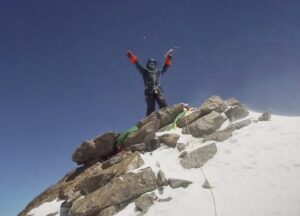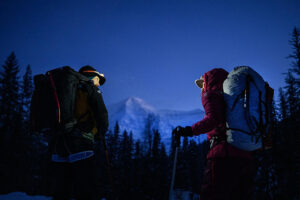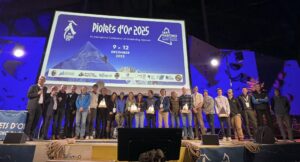Flor Cuenca of Peru made no headlines this season, despite summiting three 8,000m peaks in two months — Kangchenjunga, Nanga Parbat, and Gasherbrum II. Perhaps it is not surprising that she didn’t make waves, you might think. Just three? It doesn’t seem that impressive these days.
Except she climbed them without personal porters or bottled oxygen. She wrote on social media that she used the fixed ropes — which she admitted were indispensible for her — but pointed out some differences.
“I reached the base camps on foot, I carried my [own] gear, food, and other stuff to high camps, and I went without bottled oxygen,” she said. “Also, there was no one behind me with oxygen, in case I had a problem.”

Flor Cuenca on the summit of Gasherbrum II.
Sherpa support vs none at all
She insists that there is a huge difference between having personal support (or any sherpa support), and having none at all. It’s an exaggeration, she says, when climbers on a normal route claimed to have used “no O2 or sherpas.”
“If we climb an 8,000’er by the classic route, the support of sherpas or high-altitude porters fixing ropes is essential,” she says. “Without fixed ropes, it would take us weeks to reach the summit.”
About her ascent of Gasherbrum II (the only 8,000m peak in Pakistan she had not previously climbed), Cuenca praised Gelje Sherpa in particular. He was there supporting Adriana Brownlee.
“[Gelje] was opening the trail from C3 and went without oxygen,” she said. “After the traverse [GII requires traversing the pyramidal summit], I fell in behind them and didn’t lose sight of them. The fog made it difficult to see, but Gelje still managed to locate the rope that took us to the summit.”
Cuenca’s biggest disappointment was that she and her group summited in a total whiteout. There was no view to enjoy.

Climbers on fixed ropes. Photo: Flor Cuenca
Cuenca, the Hirkawarmi
Cuenca would have been a typical character in the 8,000m scene 20 years ago. While both commercial expeditions and heavily supported teams existed then, especially on Everest and K2, most base camps featured smaller groups or independent climbers sharing logistics and climbing permits. Today, however, climbers like Cuenca are comparatively rare.
Cuenca is a Hirkawarmi, a Quechua mountain woman who grew up in the Andes. She feels closer to the mountain peoples such as Nepal’s sherpas and Pakistan’s Baltis than she does to some clients, many of whom are unfamiliar with fragile alpine environments.
She was the first to raise her voice against the tons of rubbish in K2‘s higher camps. Earlier this season, she helped a Pakistani porter who was shivering around the tents on Nanga Parbat, and explained how he had been abandoned. (The climbers who had hired the porter later explained that a lack of communication had caused this mishap, but the fact is, it was Cuenca who let the distressed man into her tent.)
Harila on the Gasherbrums
This season has seen a well-distributed bounty of summits on the two Gasherbrums. Like the rest of the Karakoram, the weather was unstable and snowy, but climbers made the best out of short, favorable windows.
As on other peaks, Seven Summit Treks’ sherpas took the lead. They opened the trail and fixed the ropes for Kristin Harila, who was right behind them, and for their other clients.
In her summit report, Harila highlights the sherpas’ hard work, especially that of Tenjen Lama and Mingtemba Sherpa. They fixed the ropes to Camp 3, then returned to Camp 2 to help her and cameraman Gabriel Tarso on their summit push. The sherpas also fixed sections above Camp 4 as they went.
“This summit would not have been possible without them,” Harila wrote. “It’s thanks to them that we were the first team on the summit this season again.”

Kristin Harila and Tenzen Lama on the summit of Gasherbrum I on July 18. Photo: Kristin Harila/Instagram
No-O2 but not alpine style
Harila and her team then climbed GI from Camp 1 (shared by both Gasherbrums). She summited in very good weather and felt strong and healthy, so she chose to go without oxygen.
“It wasn’t very hard to climb without oxygen, but I could only do it because of great weather,” she said. Besides being physically strong, she was also hyper-acclimatized by now thanks to her many previous climbs.
Harila also noted that they went too far to the left on the final ramps to the summit: “We had to take a different, much harder route up to the top, but even then, it only took us 8h up, which is very fast.”
Then Harila wrote: “Many people criticize that the way I climb is not ‘pure’ alpinism. So was this climb pure alpinism since I used no oxygen and used only the main rope to the summit?”

Harila, left, wears an air-trim mask while roped to a sherpa climber. Photo: Kristen Harila/Instagram
What Harila means by “main rope,” according to the photos, is that she was roped to Tenjen Sherpa.
“There was no fixed rope [from Camp 3] and since it’s possible to go up with just main rope, that’s what we did,” she said.
Previously in her report, Harila wrote that the Japanese Couloir was fixed.

Topo Mena and team on the summit of Gasherbrum I on July 26. Photo: Alpenglow Expeditions
Several summit windows
In our Climber’s Guide to Gasherbrum I, Ferran Latorre explained that Gasherbrum I sometimes needs no fixed ropes at all.
On K2, climbers launched a single summit push this year. But on the Gasherbrums, teams that reached Base Camp later or were not ready initially also had summit chances. This includes Cuenca as well as Moeses Fiamoncinni of Brazil, who was recovering from a leg injury. He finally summited Gasherbrum I on the final summit push.
There were other summits on both peaks on July 19-21, on GI on July 26 and GII on July 27 — when Cuenca and the others reached the top — and on GI on August 2.
Just two left
All the 8,000m climbers have left now. In the Gasherbrums, only two men remain — Dmitry Golovchenko and Sergey Nilov of Russia. Their highly difficult goal is the south side of Gasherbrum IV. Besides the intrinsic risks of the climb, there will be no one there to help if they get into trouble.






